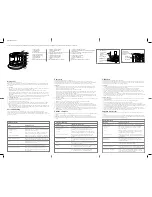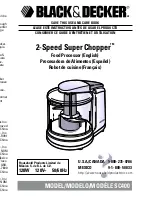
page 1 – 6
VP-8IP / Sep 2013
G E N E R A L I N F O R M A T I O N
•
Unbalanced audio connections to the VP-8
iP
should be made with shielded two
conductor cable such as Belden 8451 or 9451 as if connecting a balanced source.
At the unbalanced source’s output connect the + Output to the HI input wire and
connect the source GND wire to the LO wire. Connect the shield at the VP-8
iP
end only.
• For digital audio connections always use a good quality digital audio cable with
a characteristic impedance of 110 ohms.
The AES/EBU specification, with its broad impedance tolerance, allows for cables with
impedances from 88 ohms to 132 ohms – 110 ohms is ideal. Twisted pair cable should be shielded,
and in the case of multi-pair cable, each pair should be individually shielded. Foil shielding is
recommended for permanent installations and foil shield plus overall braid should be used in
applications where frequent flexing of the cable will occur. One cable pair is capable of carrying
two channels of digital audio.
Generic “audio” cable such as Belden 8451 may be used for interconnecting
AES3 digital audio devices but only for distances of less than about 25 feet. The
actual cable length that will work satisfactorily in an installation is primarily
determined by the error correction and jitter tolerance of the AES3 receiver
device and the cable used.
The impedance of most “analog” cables ranges from 40 ohms to 70 ohms and represents a large
impedance mismatch from the nominal 110 ohms required in the AES3 standard. Such mismatch
will result in signal reflections causing bit errors at the AES3 receiver. The higher capacitance
of generic analog cables also slows down the rise time of the digital data signals, impairing the
ability of the AES3 receiver to accurately detect digital signal transitions. This may result in
increased jitter.
Where to Install the VP-8
ip
The recommended location for the VP-8
iP
is at the transmitter site when it is in its
FM or AM processing mode. A transmitter site installation will always ensure a more
faithfully modulated signal on the air because there is better control of intervening
devices passing the peak-controlled output of the VP-8
iP
.
Additional notes regarding FM and AM mode when the unit cannot be installed at
the transmitter site:
Analog STL
Older analog STL’s can suffer from an inability to control high frequency audio
peaks because of inadequate bandwidth in their IF circuits, or inadequate low frequency
performance which will result in tilt. Also, some STL designs suffer from bounce in
their AFC loops when handling processed low frequency material, which can rob
modulation capability.
Analog Phone Lines:
We cannot recommend any form of discrete (left/right) analog “phone line” type
STL because of the inability of many service providers to guarantee flat frequency
response and proper phase matching between circuits. Furthermore, in many countries
analog circuits such as these are being discontinued or the cost has been raised to
prohibitive points.
















































